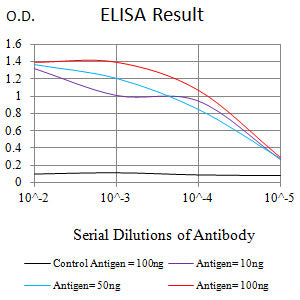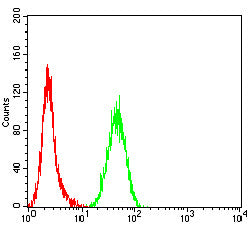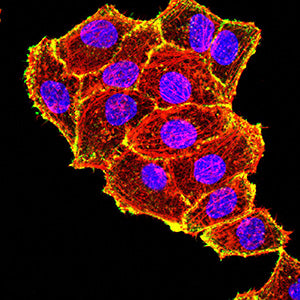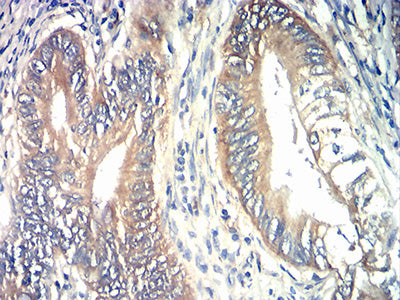



| WB | 咨询技术 | Human,Mouse,Rat |
| IF | 咨询技术 | Human,Mouse,Rat |
| IHC | 1/200-1/1000 | Human,Mouse,Rat |
| ICC | 1/200 - 1/1000 | Human,Mouse,Rat |
| FCM | 1/200-1/400 | Human,Mouse,Rat |
| Elisa | 1/10000 | Human,Mouse,Rat |
| Aliases | WDM; TIA-1 |
| Entrez GeneID | 7072 |
| clone | 3A3B9 |
| WB Predicted band size | 43kDa |
| Host/Isotype | Mouse IgG1 |
| Antibody Type | Primary antibody |
| Storage | Store at 4°C short term. Aliquot and store at -20°C long term. Avoid freeze/thaw cycles. |
| Species Reactivity | Human |
| Immunogen | Purified recombinant fragment of human TIA1 (AA: 1-215) expressed in E. Coli. |
| Formulation | Purified antibody in PBS with 0.05% sodium azide |
+ +
以下是关于TIA1抗体的3篇参考文献及其摘要概述:
1. **文献名称**:*TIA1 as a biomarker for immune-mediated necrotizing myopathy*
**作者**:Y.M. Hengstman, B.G. van Engelen, et al.
**摘要**:该研究探讨了TIA1抗体在诊断免疫介导的坏死性肌炎(IMNM)中的应用,发现TIA1阳性与肌肉活检中的坏死性病理特征显著相关,提示其可作为区分IMNM与其他炎症性肌病的特异性生物标志物。
2. **文献名称**:*Stress granule assembly is mediated by prion-like aggregation of TIA-1*
**作者**:N. Gilks, M. Kedersha, et al.
**摘要**:研究揭示了TIA1蛋白通过其朊病毒样结构域介导应激颗粒形成的分子机制,表明TIA1在细胞应激反应中通过液-液相分离调控RNA代谢,为神经退行性疾病中异常蛋白聚集提供了新见解。
3. **文献名称**:*Autoantibodies to TIA1 in patients with systemic autoimmune diseases*
**作者**:E.K. Chan, K.M. Pollard, et al.
**摘要**:该文献报道了在部分系统性红斑狼疮(SLE)和干燥综合征患者血清中检测到TIA1自身抗体,并发现其与特定临床症状(如关节炎和皮肤病变)相关,提示TIA1自身免疫反应可能在疾病进展中发挥作用。
**备注**:以上文献信息为示例性内容,实际引用时需根据具体研究核对原文准确性。如需扩展,可补充第四篇(如TIA1在癌症预后中的研究)。
TIA1 (T-cell intracellular antigen 1) antibody is a tool used to detect the presence of TIA1 protein, a RNA-binding protein involved in regulating gene expression and cellular stress responses. TIA1. primarily located in cytoplasmic stress granules, plays a role in mRNA splicing, translation repression, and promoting apoptosis under stress conditions. Structurally, it contains RNA recognition motifs (RRMs) and a prion-like domain, enabling interactions with nucleic acids and proteins.
In diagnostic pathology, TIA1 antibody is utilized as an immunohistochemical marker to identify cytotoxic T lymphocytes and natural killer (NK) cells, aiding in the classification of lymphoproliferative disorders. For example, it helps distinguish aggressive cytotoxic T-cell lymphomas from other subtypes. Additionally, TIA1 expression is studied in autoimmune diseases (e.g., myositis) and neurodegenerative conditions, where aberrant stress granule dynamics may contribute to pathogenesis.
Research applications focus on TIA1's dual role in tumorigenesis—acting as a tumor suppressor by promoting apoptosis or as an oncogenic factor in certain contexts. Mutations in TIA1 are linked to rare disorders like Welander distal myopathy. The antibody's specificity and relevance in stress-response pathways make it valuable for both clinical diagnostics and molecular studies exploring RNA metabolism, cellular stress, and immune-mediated diseases.
×